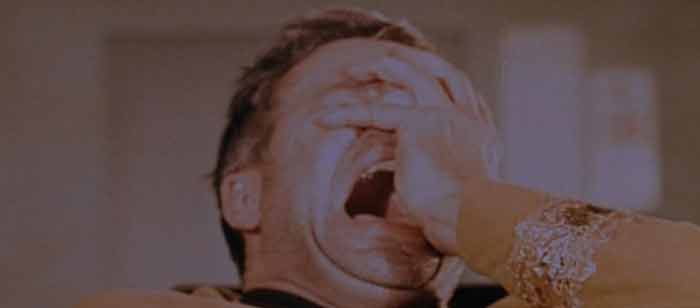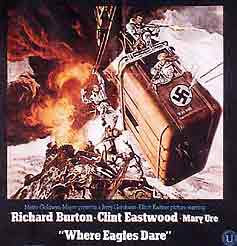
|
. |
I think this will be the stupidest, most geeked-out thing I’ve ever written. I think I need an intervention: dude, it was one cheesy episide of one cheesy show. Give it up. But if you’ve ever spent 30 years looking for a particular piece of music – and found it! – then you might understand why I feel compelled to explain, once and for all, why – No. Save it. Let’s go back. Let’s go way back. The Woolworth’s in Fargo smelled of mothballs and hamburgers. It had a soda fountain on the north wall, an escalator on the other side. It was the only escalator in town, as far as we knew, and that’s where we practiced jumping off just in time before those sharp steel teeth got a chance to bite. Did you hear about the kid whose laces got caught? He was dragged inside. True story. Upstairs there was nothing for kids – hairnets, brooms, bras, mom stuff. Downstairs had a limited selection of toys, the standard array of candies, creaky wire racks of books and comics. If you were on your own you might buy one and read it at the counter. The pop came in paper cups nestled in metal cones; the paper went soggy after one or two sips, and you had to keep turning it to keep the stuff from dribbling on your lap. They also had records. Cut outs. They were records I never saw at Ben Franklin or the drug store; they were odd, peculiar, off-brand, and they all had a hole punched in the upper left-hand corner. You inferred quickly that this was a badge of failure, of shame. That Herb Alpert cover with the girl covered in whipped cream? You’d never find that on in this bin. More likely you’d find Artie Johnson covered in whipped cream, some ha-ha parody they unloaded on the chains for pennies. Woolworth sold the cut-outs for 88 cents. I found this one.  I bought it; what 12 year old boy wouldn’t? Nazis and cable cars and castles blowing up – can’t miss. I memorized the score before I ever saw the movie, and when I finally saw the film I was annoyed that they talked over the music, put explosions over the music, added sound effects. The score was the movie for me. It recently came out on DVD, and I bought it, because I hadn’t heard the music in a decade or two. Of course, I’d forgotten that they talked over it, added explosions, etc. I began a search for the soundtrack, and lo: I got part of it. You’ll either shrug or think “see what you mean.” It depends on your attitude towards war movie music. Most of it I don’t like, because it’s either jingo-riffic or inordinately downbeat. American martial music? There’s not much – well, aside from “Victory at Sea,” which I’m not counting. (Which is like saying “the Germans didn’t contribute much to music, aside from Bach through Mahler.”) Typical American martial music: “Anchors Away” played with sledgehammer force. Listen to soundtracks from WW2 movies and everything sounds like the Army or Navy band laying into “Anchors Away” like they’re trying to beat a confession out of it, with a little tootling fife always dancing around the margins. German martial music always has that ludicrous oompah that makes it sound buffoonish. So most of the genre leave me cold. But ”Where Eagles Dare” grabbed me. Here’s a portion of the opening theme. A plane carrying Our Brave Agents heads into enemy territory. It starts out with a martial snare; doubles it; ups the volume; adds the muffled drum as if to foreshadow a funeral. Then it makes a remarkable change in mood simply with a crescendo in the percussion, after which a mountain range comes out of nowhere. Whoa. At this moment you know exactly who the enemy is: Nazis. The rest of the soundtrack is good, but contains too many pieces used to underscore tension or success, and the strings have that odd echoing effect favored in the late 60s. But the last piece, “The Chase to the Airfield,” is everything I remembered. Here’s the last forty seconds. Think they made it to the plane and safety in time? After leaving Woolworth’s there wasn’t much to do; you could get on your bike and go to the library, or head over to the 2nd hand paperback store to pick up battered sci-fi novels, most of which were either set in an impossibly distant future you’d never have or a miserable post-nuclear future you probably would. Home for supper; TV afterwards, with a monster movie after 10 on WDAY. Sometimes they played 50s sci-fi movies, and if you were lucky you got “The Monolith Monsters,” a peculiar favorite; if you were very lucky you got “Them,” which was the Best Bug Movie EVER. The best stuff was over, though. It all ended with they cancelled Star Trek, you know. I saw the first episode ever aired, as I’ve noted before, sitting on the floor at my Grandfather’s farm. And I saw the last episode at home. You kids today with your Star Wars and Matrix and Andromeda and Babylon-5 and Stargate SG-1 and all the rest have no idea what sort of drought we faced in the early 70s. When that last episode of Star Trek aired you could almost imagine the Enterprise towing the prospect of additional cool sci-fi off into the inky star-flecked void with it. From here on it was Hee Haw and the Jeffersons. But by 1973 Trek was running in syndication, and I watched them all with slavish devotion. I had to leave halfway through every episode, though; had a paper route. Naturally, I quit the paper route. Long time Bleat readers are probably thinking Oh fer chrissakes he’s not going to bring up the fargin’ “Doomsday Machine,” again? Hello! Rigel to Lileks! Enough! It’s just a TV show! Of course. But now I know why it made such an impression then, and why I enjoy it now. A few months ago a reader emailed me re: a bleat concerning music cues in TV; he said the Trek music cues were actually scored to the individual episodes. I thought that was odd – they seemed to recycle the same cues over and over again. They didn’t write scores for individual episodes, did they? Well, imagine my surprise. There were a few scores written for specific episodes, and their highlights were recycled over and over. On Amazon I found the soundtrack for “The Doomsday Machine,” and of course I snapped it up. It arrived last Wednesday. To my surprise this score, written for the “Doomsday” episode, is the source of half the series' cues. But they're intended to belong together, and that’s one of the reasons the episode works like few others: it has a unique symphonic score. Played start to finish, it holds together. Ladies and Gentlemen, I give you highlights from The Doomsday Machine Suite by unjustly neglected composer, Sol Kaplan. Shall we begin?  Here’s the cue for the approach of the Enterprise to the demolished Constellation. Military funeral trumpets, muffled drums. Then Alex Courage’s opening theme fanfare is handed over to the cellos as a morose dirge, and they Mahlerate the thing.  "They say there's no devil, Jim, but I've seen it." Here's the music that underscores Commander Decker describing the horrible machine that killed his crew and demolished a planet. We haven’t seen the machine yet. The music is sodden with dread, and it has a cue the show used sparingly: a panicked piano glissando that suggested something bad enough to drive you nuts. In this cue, Decker has assumed command of the Enterprise, and no, I can’t really believe I’m writing this, but hell, I’m in too deep. You can tell the wrong man has control of the ship – listen how Kaplan contorts the Trek fanfare. Again, there’s lots of late-period Mahler in here, if you define that as having the cellos play at the top of their range.  This cue was used repeatedly for moments of Tense Manly Conflicts of Wills, but here it’s quite specific. Spock attempts to relieve Decker of command. Kaplan recasts the opening fanfare of Courage’s theme again, this time making it sound like court-martial music. Decker concedes, and we hear what has become his theme. Then it’s smiles all around as Spock takes the helm!  Obviously I can’t excerpt everything relevant. But of course I have to include this. Kirk riding the Constellation into the sparkly maw of Hell’s cornucopia, waiting for the beamout. Do you think John Williams heard this piece? Just curious. Yes, the abrupt edit is cruel. So buy the CD. Sol worked hard on this one, and it burrowed its way into the brains of untold Trek lovers. Put it this way: he’s the reason that several dozen million people subconsciously associate a rising melody on a bassoon with Spock’s arched eyebrow. The disc also includes the half-arsed Stravinsky score to “Amok Time,” which we will discuss next week. Any questions? Yes, you there, Mr. Riley. “Uh, are you saying that these soundtracks should be considered the equal of actual symphonies? Of course not, no. A symphonic movement expresses ideas with far greater sophistication over a longer period of time, and does not exist to underscore visual elements. Anyone else? Mr. Finnegan. “Ah sure, Jimmy, but does it matter?” Yes, it does. But in another sense, it really doesn’t. I’ve listened to Berwald’s First Symphony fifty times, and nothing much sticks. Ten bars of a Kaplan score and I know exactly where I am. Take it for what it’s worth. Class dismissed. Have a good weekend. Oh - and don't forget, next week's assignment is "Reagan, Skywalker, Korngold: Heroic Amputation in American Cinema." I expect you will have read the materials. Or at least googled the keywords. |
||||
|
|
.....


